Ledger art
Ledger art is a term for narrative drawing or painting on paper or cloth, predominantly practiced by Plains Indian, but also from the Plateau and Great Basin. Ledger art flourished primarily from the 1860s to the 1920s. A revival of ledger art began in the 1960s and 1970s. The term comes from the accounting ledger books that were a common source of paper for Plains Indians during the late 19th century.
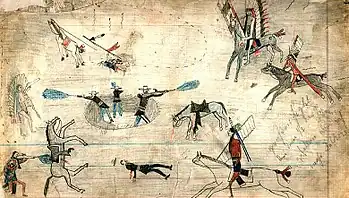
Battle exploits were the most frequently represented themes in ledger art. Many ledger artists documented the rapidly changing environment by portraying new technologies such as trains, as well as encounters with European Americans and American soldiers. Other themes such as religious practices, hunting, and courtship were also subjects. Many ledger artists worked together with ethnologists, to document cultural information such as shield and tipi designs, winter counts, dances and regalia.
Historical precedents
Ledger art evolved from Plains hide painting.[1] Among Plains tribes, women have historically painted abstract geometrical designs, such as those found in parfleches, whereas men paint representational designs. The men's designs were often heraldic devices or visions painted on shields, tipis, shirts, leggings, or robes. Before the Plains tribes were forced to live on reservations in the 1870s, men generally painted personal feats in battle or hunting.[2] Plains ledger art depicted communally acknowledged events of valor and tribal importance in order to gain status for the individuals who participated in them, and their band and kin. Plains pictorial art emphasizes narrative action and eliminates unnecessary detail or backgrounds.[3] Figures tended to be drawn in hard outlines and filled with solid fields of color.[4]
These narrative works were all historically painted on animal hides – particularly buffalo hides. When buffalo became scarce after the US federal government's eradication programs, Plains artists began painting and drawing on paper, canvas, and muslin.[1]
Subject matter

Battle exploits dominated ledger art. Other themes such as hunting, courtship,[5] and religious practices were common subjects. Ledger artists also documented their rapidly changing environment by portraying encroaching European Americans and new technologies such as trains and cameras. Many ledger artists worked with ethnologists, by documenting shield and tipi designs, ethnobotanical information, winter counts, dance customs and regalia, and other cultural information. Dreams and visions inspired ledger art just as they had inspired earlier hide paintings.[6]
The artists creating ledger art today often reference pre-reservation lifeways, historical transitions, and social commentary. They use this style to illustrate cultural continuity between historical and contemporary Native life.[5]
New materials
An increasing supply of ledger books and other paper came from traders, government agents, missionaries, and military officers.[7] With these came pencils, ink fountain pens, crayons, and watercolor paints.[8][9] These new tools allowed for greater detail and experimentation than the earlier tools, such as bone or wood styli dipped in mineral pigments, had. The compact ledger books and pencils were highly portable, making them ideal for nomadic lifestyles.[10]
Communal authorship
The creation of ledger art at times involved communal authorship, with more than one artist contributing to an individual drawing, and several artists working within a specific ledger book.[11] Many of the earlier ledger book drawings contained several signature glyphs, suggesting shared authorship.[11] Examples of shared authorship are found in the Dog Soldiers ledgers, in which many of the drawings attributed to Bear with Feathers indicate that he drew the human figures, but another artist drew the horses.[12] In 1877, a Northern Arapaho man named Friday, ally of the Northern Cheyenne, described communal drawing to Army Lt. John G. Bourke, stating that it was "extremely common" for close friends to draw in each other's books.[13]
Fort Marion
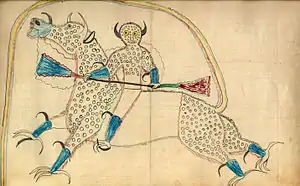
Some well-known ledger artists were prisoners of war at Fort Marion in St. Augustine, Florida.[14] In 1874, in what became known as the Red River War or Buffalo War, a group of Cheyenne, Kiowa, Comanche, warriors fought the US Army to protect the last free herd of buffalo and to assert their autonomy.[15] In the harsh winter of 1874 to 1875, many tribal camps were forced to surrender to various Indian agencies, and the supposed leaders of the Red River War were rounded up and sent to Fort Marion.[16] From 1875 to 1878, the 71 men and one woman were under the command of Richard Henry Pratt, who used the opportunity to give the Indians a Western education.[17] He also provided the prisoners with basic art supplies, such as pencils, ink, crayons, watercolor paint, and paper.[18]
Twenty-six of the Fort Marion prisoners engaged in drawing. They were younger Cheyenne, Arapaho, and Kiowa men.[19] Some of the most prolific and well-known artists include Paul Caryl Zotom (Kiowa); David Pendleton Oakerhater or Making Medicine (Cheyenne); Tichkematse or Squint Eyes (Cheyenne), who later worked for the Smithsonian Institution in Washington, DC; Wohaw (Kiowa); Howling Wolf (Cheyenne); Etahdleuh Doanmoe (Kiowa); White Bear (Arapaho); Koba (Kiowa); and Bear's Heart (Cheyenne). Tichtematse, Howling Wolf, White Bear, and Koba all continued drawing after their release from prison.[20]
Cheyenne Dog Soldier artists
Following a July, 1869 battle at Summit Springs in northeastern Colorado, a ledger book was retrieved from the Cheyenne's burned village. A Cavalry trooper's notations on one of the pages states, "This book was captured by the Fifth U.S. Cavalry on their charge through the Indian Village July 10th 69."[12] The collection of drawings are known as the Summit Springs Sketchbook, or Dog Soldier Ledger Book. The drawings in the book depict events and people from the period between the 1864 Sand Creek Massacre and the 1869 Summit Springs Battle.[21][11]
Major artists
- Bear With Feathers - created 25 drawings in which he rendered the human figures, and it appears that another artist drew the horses.[12]
- White Bird - created seventeen drawings, fourteen of which were autobiographical.[12]
- Red Lance - created sixteen drawings, six of which are autobiographical, two depict Buffalo Robe, three depict White Horse, and the rest depict other warriors. Red Lance often drew horses in true profile.[12]
- Unidentified artist (Two Birds or Black Bear) - created ten pages. Two Birds is depicted with a complete eagle feather fall, and carrying a red shield; Black Bear is depicted with an upright headdress with several ermine tails.[12]
Minor artists
White Horse created three drawings using the "X-ray technique". Pistol created three autobiographical drawings using the X-ray technique. Tomahawk created four highly graphic drawings. White Wolf created five drawings, three of which were autobiographical. Warrior X (unnamed) created three autobiographical drawings.[12]
Amidon ledger book drawings
Dated from around 1885, the Amidon ledger book was named for the place it was found in Amidon, North Dakota, in a storage box at the Slope County Court House. The principal artist was Jaw (Ćehu′pa) or His Fight (Oki'cize-ta'wa), a Hunkpapa (Húŋkpapȟa) Lakota man, who created 87 of the more than 107 drawings in the ledger book.[22] After being scanned and inventoried,[23] this historical object of cultural value was then dismantled as individual drawings that were sold on the open market to private collectors and institutions; a commercial trend in the 20th and early 21st centuries. Ross Frank, director of the UCSD Plains Ledger Art Project[24] states that "Commercialization of ledger art starts with the Fort Marion artists. It's a process of the non-Indian world appropriating Indian art as trophies and souvenirs."[25]
Other ledger books
Cheyenne
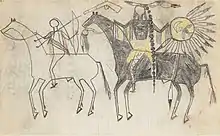
Cheyenne ledger books include:[14][23]Abbott Ledger (Cheyenne, Northern Cheyenne);[26] Arrow's Elk Society Ledger (Cheyenne, Southern Cheyenne);[27] Bear's Heart Ledger Book (Southern Tsisistas/Cheyenne) 24 drawings in graphite and crayon signed by the artist, c. 1875/1876;[14][28][29][30] Bethel Moore Custer Ledger (Cheyenne, Northern Cheyenne), c. 1881;[11] Black Horse Ledger (Cheyenne, Northern Cheyenne), c. 1877-1879;[31][32][33] Cheyenne Bowstring Warrior Society (Cheyenne, Southern Cheyenne), pencil, colored pencil, c. 1850s;[34][35] Coe-Cheyenne Ledger (Cheyenne, Southern Cheyenne); Dunham Album (Cheyenne, Southern Cheyenne), pencil and colored pencil;[36] Ewers Ledger (Cheyenne, Northern Cheyenne), pencil and colored pencil;[37] Frank Henderson Ledger (Southern Inuaina and/or Southern Tsistisistas), c. 1882;[38] Keeling Ledger (Cheyenne, Northern Cheyenne), 115 drawings in pencil and colored pencil;[39][40] Little Shield Ledger–Schøyen (Cheyenne, Northern Cheyenne), a significant pictographic source for the Platte River Indian war. Drawings, name glyphs and cursive script by Little Shield and Black Moon, 1865–1879;[41] Little Whirlwind Ledger also known as Prisoner's Ledger Drawing Book (Cheyenne, Northern Cheyenne) 1897-1898. Drawings by Little Whirlwind of the Tongue River Reservation, drawn while in prison (for a crime he did not commit) at the Miles City, Montana jail;[42] Mad Bull Ledger (Arapaho and Southern Cheyenne); c. 1884[43] Northern Cheyenne Ledger-Kansas State Historical Society (Cheyenne, Northern Cheyenne), drawn by Northern Cheyenne warrior-artists during imprisonment for alleged crimes in the Dodge City jail, pencil, colored crayons, red watercolor, black ink, c. 1878-1879;[44][45][46] Pamplin Cheyenne/Arapaho Ledger (Arapaho and Southern Cheyenne);[47] Porcupine Ledger-Schøyen (Cheyenne, Northern Cheyenne), pencil and crayon drawings by Northern Cheyenne leader Porcupine in Dodge City Jail. Dodge City, Kansas, 1879;[48] Rodolphe Petter Cheyenne Ledger (Cheyenne, Southern Cheyenne), drawn during the 1890s in pencil, pen and black ink;[49][50] Sheridan Ledger (Cheyenne, Southern Cheyenne), pencil and colored pencil, "Artist C" is Arrow;[51] Soldier's Diary Ledger (Cheyenne, Northern Cheyenne), pencil, colored pencil, c. 1876;[52] Spotted Hawk Ledger (Cheyenne, Northern Cheyenne), drawn by Spotted Hawk in pencil and colored pencil in Miles City jail, Miles City, Montana, c. 1897;[53] Tie Creek Ledger Book (Cheyenne, Northern Cheyenne), Drawn in colored pencil, lead pencil, pen and ink, watercolor. Cover inscription by Jas Clayton states: "Pictures drawn by Wild Hog and other northern Cheyenne Indian Chiefs while in the Dodge City jail in May 1879";[54] Wild Hog Ledger-Kansas State Historical Society (Cheyenne, Northern Cheyenne), c. 1879;[55][56] Wild Hog Ledger-Schøyen (Cheyenne, Northern Cheyenne), drawn by Wild Hog, Kansas in 1879. Ledger book is smaller than most, approximately 3"x5".[57][45]
Kiowa
Kiowa ledger books include:[14][23] Bad Eye Sketchbook (Kiowa); Etadleuh Doanmoe Sketchbook - Rice County Historical Society (Kiowa); Finley-Kiowa Ledger No. 1 (Kiowa); Finley-Kiowa Ledger No. 2 (Kiowa); Kiowa Sketchbook - Davis Museum (Kiowa); Koba-Russel Sketchbook (Kiowa); Silver Horn Ledger Book – Nelson-Atkins (Kiowa); Zotom Sketchbook - Taylor Museum (Kiowa)
Lakota (Sioux)

Lakota (Sioux) ledger books include:[14][23] Black Hawk Ledger (Lakota Sioux, Sans Arc); Black Road - Wilkins Ledger (Lakota Sioux); Fales-Freeman Brulé Ledger (Lakota (Sioux) Brulé; Lakota (Sioux) Sicangu); Goodwyn Ledger (Lakota Sioux); Jaw-Amidon Ledger (Lakota (Sioux) Hunkpapa); Jaw-Macnider Ledger (Lakota Sioux); Leatherwood/Scares the Enemy Ledger (Lakota (Sioux) Brulé); Rosebud School Album (Lakota Sioux–Brulé); Sitting Bull (Oglala) – Saville Ledger (Lakota Sioux); Sweetwater Ledger Book (Lakota Sioux); Walter Bone Shirt Ledger (Lakota Sioux–Brulé); Walter Bone Shirt Ledger - Mansfield Library (Lakota Sioux-Brulé)
Commodification and dispersal
In the 20th and 21st centuries, many of the ledger books were unbound, and the individual drawings were sold by commercial galleries and auction houses to individual collectors and institutions as "hot commodities in the art market" costing tens of thousands of dollars per drawing.[58] The narrative order of the drawings in these books was lost when they were sold page-by-page, after having been stolen, scavenged or gifted by non-native people, thus losing "the integrity of the full ledger book".[58][25] The roots of this commercialization can be traced to the late 19th century, when the founder of the Carlisle Indian School, Col. Richard Pratt began to teach entrepreneurial values to the Fort Marion prisoners of war. Artists held in this prison camp, such as Zotom and Howling Wolf were trained to create drawings on commission to "wealthy white patrons" in his efforts to assimilate the prisoners.[59]
Easel arts
Missionaries, anthropologists, and tourists eagerly collected ledger books in the late 19th century. Carl Sweezy (Southern Arapaho, 1881–1953)[60] and Haungooah (Silver Horn) (Kiowa, 1860–1940) both established professional careers as ledger artists.[60]: 117
These early Southern Plains easel artists in turn inspired the Kiowa Six. These artists painted with Western art-grade materials and met with international success when they exhibited their work in the 1928 International Art Congress in Prague, Czechoslovakia.[61]
Contemporary interpretations
Numerous Northern and Southern Plains artists create ledger paintings, today, including many women artists despite Plains narrative figurative painting being a masculine art genre in the past.[62]
Notable ledger artists
Historical
- Amos Bad Heart Bull, Oglala Lakota
- Black Hawk, Sans Arc Lakota
- Howling Wolf (Cheyenne) Bow String Warrior Society Member
- Jaw (Ćehu′pa) or His Fight (Okicize Tawa) (ca. 1853-1924), Hunkpapa Lakota, created the Amidon Ledger[1]
- Michael Horse, Yaqui/Mescalero Apache/Zuni-descent[5]
- Annie Little Warrior (Hunkpapa Lakota, 1895–1966)[63]
- Red Horse (Lakota chief), Lakota, 42 ledger drawings of Battle of the Little Big Horn
- St. David Pendleton Oakerhater, Southern Cheyenne, member of the Bow String Warrior Society
- Silver Horn, Kiowa
- Sitting Bull, Hunkpapa Lakota[64]
- White Horse, Kiowa
- Yellow Nose, Ute, captured as a Child by Cheyenne. Dog Soldier Warrior Society Member
Contemporary
- Sharron Ahtone Harjo (Kiowa)[65]
- Arthur Amiotte (Oglala Lakota)
- Sherman Chaddlesone (Kiowa, 1947–2013)
- Linda Haukaas (Sicangu Lakota)[65]
- Terran Last Gun (Piikani Blackfoot)
- Chris Pappan (Kaw/Osage/Cheyenne River Lakota)
- Harvey Pratt (Cheyenne-Arapaho Tribes)
Gallery
 Ledger drawing - Cheyenne and Pawnee or Osage fight
Ledger drawing - Cheyenne and Pawnee or Osage fight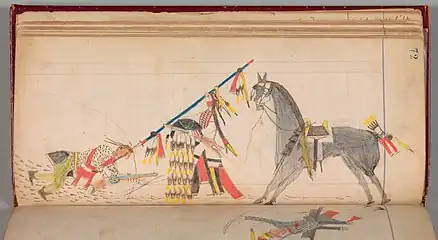 Maffet Ledger - Drawing Metropolitan Museum DP318424
Maffet Ledger - Drawing Metropolitan Museum DP318424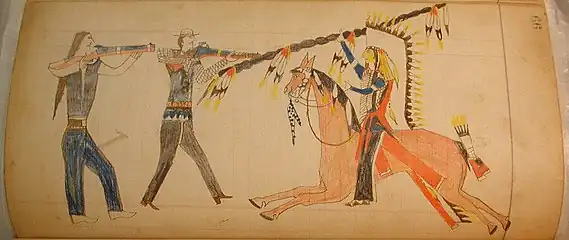 Maffet Ledger - Drawing Metropolitan Museum page66; graphite, watercolor and crayon
Maffet Ledger - Drawing Metropolitan Museum page66; graphite, watercolor and crayon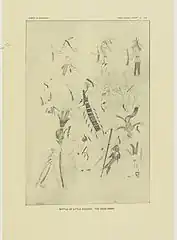 Red Horse Ledger art of Lakota Killed at Little Bighorn. Published as Plate XLIV
Red Horse Ledger art of Lakota Killed at Little Bighorn. Published as Plate XLIV_(19367428281).jpg.webp) Red Horse Ledger art of Lakota killed at Little Bighorn. Published as Plate XLV
Red Horse Ledger art of Lakota killed at Little Bighorn. Published as Plate XLV
See also
References
- "Ledger Art History." Department of Ethnic Studies, University of California San Diego: Plains Indian Ledger Art Project. 2011 (retrieved 2 Oct 2011)
- Hansen, 138
- Greene, 11
- Greene, 63
- Fauntleroy, Gussie. "Ledger Art: Looking Between the Lines." Native Peoples. Sept/Oct 2011 (retrieved 7 Aug 2011)
- Hansen, 140
- Swan, 70
- Hansen, 139
- Blish, Helen H.; Sandoz, Mari (1967). A Pictographic History of the Oglala Sioux. Drawings by Amos Bad Heart Bull. Lincoln: University of Nebraska Press. LCCN 66-13404. OCLC 587180.
- Greene, 13
- Low, Denise (Summer 2006). "Composite Indigenous Genres: Cheyenne Ledger Art as Literature". Studies in American Indian Literatures. 18 (2): 83–104. doi:10.1353/ail.2006.0027. JSTOR 20737318. S2CID 161933086. Retrieved 16 October 2020.
- Afton, Jean (Fall 1989). "The Dog Soldier Artists: Plains Indian Ledger Drawings". The Clarion.
- Powell, Peter J.; Malone, Michael P. (1976). Montana, Past and Present. Los Angeles: University of California/William Andrews Clark Memorial Library. pp. 36–37.
- "Keeping History: Plains Indian Ledger Drawings". Smithsonian Institution. Retrieved 16 October 2020.
- Szabo, 12–14
- Szabo, 14
- Szabo, 25
- Petersen, Karen Daniels (1971). Plains Indian Art from Fort Marion. Norman, OK: University of Oklahoma Press. ISBN 0-8061-0888-6.
- Szabo, 29
- Szabo, 110
- "Cheyenne Dog Soldier Ledgerbook". History Colorado. Retrieved 16 October 2020.
- "Jaw-Amidon Ledger, Lakota (Sioux) - Hunkpapa". Plains Indian Ledger Art. Retrieved 21 October 2020.
- "42 Ledgers". Plains Indian Ledger Art. University of California, Department of Ethnic Studies. Retrieved 21 October 2020.
- "Ross H. Frank". University of California, San Diego. Retrieved 21 October 2020.
- Field, Kimberly (August 2017). "Collecting Ledger Art" (PDF). Cowboys and Indians Magazine: 92–97. Retrieved 21 October 2020.
- "Abbott Ledger". Plains Indian Leger Art. UCSD. Retrieved 21 October 2020.
- Cowdrey, Mike (1999). Arrow's Elk Society Ledger: A Southern Cheyenne Record of the 1870's. Santa Fe: Morning Star Gallery. Retrieved 21 October 2020.
- "Book of Drawings, c. 1876: Bear's Heart". Minneapolis Institute of Art. Retrieved 21 October 2020.
- Meier, Allison (26 February 2016). "A 19th-Century Cheyenne Warrior's Drawings of His Life as a POW". Hyperallergic. Retrieved 21 October 2020.
- Supree, Burton; Ross, Ann; Bear's Heart (drawings) (1977). Bear's Heart: Scenes From the Life of a Cheyenne Artist of One Hundred Years Ago. Philadelphia: J.P Lippencott. ISBN 9780397317462.
- "Black Horse Ledger". Terra Foundation. Retrieved 21 October 2020.
- "Black Horse Ledger". Edward E. Ayer Digital Collection (Newberry Library). Retrieved 21 October 2020.
- "Black Horse Ledger". UCSD-Plains Indian Ledger Art Project. Retrieved 21 October 2020.
- Winnerman, Jim (2 March 2017). "Confined Indian Chiefs and Warriors Recorded Their Changing Lives on Paper". HistoryNet. Retrieved 21 October 2020.
- "Cheyenne Bowstring Warrior Society". UCSD/PILAP. Retrieved 21 October 2020.
- "Dunham Album". UCSD/PILAP. Retrieved 21 October 2020.
- "Ewers Ledger". UCSD/PILAP. Retrieved 21 October 2020.
- "Ledger Drawings". Hood Museum. March 2018. Retrieved 21 October 2020.
- "Cheyenne Indian Art". History Nebraska. Retrieved 21 October 2020.
- "Keeling Ledger". UCSD/PILAP. Retrieved 21 October 2020.
- "Cheyenne Chief Little Shield's Ledger Book". The Schoyen Collection. Retrieved 21 October 2020.
- "Prisoner's Ledger Drawing Book". The Schoyen Collection. Retrieved 21 October 2020.
- "Mad Bull Ledger". UCSD/PILAP. Retrieved 21 October 2020.
- "Native American Ledger Art". Kansas Historical Society. Retrieved 21 October 2020.
- Low, Denise; Powers, Ramon (Spring 2012). "Northern Cheyenne Warrior Ledger Art: Captivity Narratives of Northern Cheyenne Prisoners in 1879 Dodge City" (PDF). Kansas History: A Journal of the Central Plains. 35: 2–25. Retrieved 21 October 2020.
- "Northern Cheyenne Ledger-Kansas State Historical Society". Retrieved 21 October 2020.
- Bates, Craig D.; Kahn, Bonnie B.; Lanford, Benson L. (2003). The Cheyenne/Arapaho Ledger Book: From the Pamplin Collection. Pamplin Collection of American Indian Art Publisher. ISBN 9780971050600. OCLC 52512367. Retrieved 21 October 2020.
- "Porcupine Ledger-Schøyen". UCSD/PILAP. Retrieved 21 October 2020.
- "Rodolphe Petter Cheyenne ledger drawings". Mennonite Library and Archives, Bethel College. Retrieved 21 October 2020.
- "Rodolphe Petter Cheyenne Ledger". UCAD/PILAP. Retrieved 21 October 2020.
- "Sheridan Ledger". UCSD/PILAP. Retrieved 21 October 2020.
- "Soldier's Diary Ledger". UCSD/PILAP. Retrieved 21 October 2020.
- "Spotted Hawk Ledger". UCSD/PILAP. Retrieved 21 October 2020.
- "Tie Creek Ledger Book". UCSD/PILAP. Retrieved 21 October 2020.
- "Pictures drawn by Wild Hog and other Cheyenne Indians". Retrieved 21 October 2020.
- "Wild Hog Ledger-Kansas State Historical Society". UCSD/PILAP. Retrieved 21 October 2020.
- "Wild Hog Ledger-Schøyen". UCSD/PILAP. Retrieved 21 October 2020.
- Adams, James (18 July 2014). "Exploring the legacy of American Plains Indians ledger drawings, an art form weighted by tragedy". The Globe and Mail. Retrieved 21 October 2020.
- Gilio-Whittaker, Dina (24 April 2014). "The Good, the Bad and the Ugly: Culture as Commodity". Indian Country Today.
- Morand, Anne; Smith, Kevin; Swan, Daniel C.; Erwin, Sarah (2005). Treasures of Gilcrease Selections from the Permanent Collection. Gilcrease Museum. p. 107. ISBN 9780806199566. Retrieved 11 October 2022.
- Wishart, David J. "Kiowa Six". Encyclopedia of the Great Plains. Retrieved 11 October 2022.
- Pearce, p. xiii
- "Women and Horses: Annie Little Warrior". Smithsonian Institution. Retrieved 4 October 2021.
- "Sitting Bull's ledger drawings." Smithsonian Institution Collections Search Center. (retrieved 14 Aug 2010)
- Szabo, Joyce (2015). "Women and Ledger Art: Four Contemporary Native American Artists by Richard Pearce". Museum Anthropology. 38 (1): 46–62. doi:10.1111/muan.12072. Retrieved 20 May 2023.
Further reading
- Greene, Candace S. Silver Horn: Master Illustrator of the Kiowas. Norman: University of Oklahoma Press, 2001. ISBN 0-8061-3307-4.
- Hansen, Emma I. Memory and Vision: Arts, Cultures, and Lives of Plains Indian People. Cody, WY: Buffalo Bill Historical Center, 2007. ISBN 0-295-98580-1.
- Pearce, Richard. "Women and Ledger Art: Four Contemporary Native American Artists." University of Arizona Press, 2-13. ISBN 978-0-8165-2104-3.
- Swan, Daniel C. Peyote Religious Art: Symbols of Faith and Belief. Jackson: University of Mississippi Press, 1999. ISBN 1-57806-096-6.
- Szabo, Joyce M. Art from Fort Marion: The Silberman Collection. Norman: University of Oklahoma Press, 2007. ISBN 978-0-8061-3883-1.
External links
- Ledger drawings in the Smithsonian Institution's collections
- Ledger Art Collection at the Milwaukee Public Museum
- Plains Indian Ledger Art Project, University of California, San Diego
- Keeping History: Plains Indian Ledger Drawings, Online exhibition from Smithsonian Institution